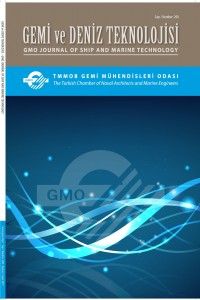Öz
Buhar Devreleri Boru Tasarımı ve Boru Gerilme Analizi
Ahmet Dursun Çetin, İsmail Bayer
Gemi İnşaatı ve Denizcilik Fakültesi, Yıldız Teknik Üniversitesi, İstanbul, Türkiye
Boru hatları çok geniş bir alanda ve çok değişik basınç ve sıcaklıklardaki gaz ve sıvı akışkanların taşınmasında kullanılır. Boru hatları üzerinde çalışılırken, optimum boru çapının belirlenmesi, optimum yalıtım kalınlığının belirlenmesi ve gerilmelerin en ekonomik biçimde alınmasına çözüm aranılır. Boru tasarımı da esas olarak gerilme analizine bağlıdır. Proses boruları ve güç boruları boru stres mühendisleri tarafından rotalama, nozul yükleri, desteklerin doğru yerleştirildiğini ve seçildiğini, izin verilen boru farklı yükler durumunda izin verilen değerlerin aşılmadığını doğrulamak için kontrol edilir. Boru hatları Endüstriyel / Uluslararası Kodlar ve Standartlar tarafından yönetilir. Bu çalışmada da bu standartlardan biri olan ASME B31.1 koduna istinaden, enerji gemisi üzerinde bulunan buhar türbini borulamasındaki esneklik özelliklerini, ekipman nozuluna gelen yükleri ve boru yer değiştirmelerinin nedenleri ve etkilerini incelemektedir. Aynı zamanda boru gerilmeleri hesaplama yöntemlerini, sonlu elemanlar boru gerilme analizi programı ile enerji gemisi üzerinde bulunan buhar devresi borulamasının üzerindeki sürekli yüklerin, ara sıra oluşan yüklerin ve termal durumdaki yüklerin iki farklı boru tasarımı için hesaplamaları yapılmıştır. İnceleme neticesinde boru tasarımının boru gerilme analizine bağlı olduğu belirlenmiştir ve sonlu elemanlar boru gerilme analizi programları yardımıyla yapılan analizler boru üzerindeki gerilimler hakkında net bir resmin elde edilmesini sağladığı görülmüştür.
Steam Systems Pipe Design and Pipe Stress Analysis
Ahmet Dursun Çetin, İsmail Bayer
Faculty of Naval Architecture and Maritime, Yildiz Technical University, Istanbul, Turkey
Pipelines are used for transporting gas and liquid fluids in very wide areas and at very different pressures and temperatures. When working on pipelines, a solution is sought to determine the optimum pipe diameter, determine the optimum insulation thickness and take the stresses in the most economical way. Pipe design mainly depends upon stress analysis. Process piping and power piping are checked by pipeline stress engineers to verify that the positioning, nozzle loads, supports are correctly positioned and selected, and that the permissible pipe is not exceeding the permissible values for different loads. Pipelines are governed by Industrial / International Codes and Standards. In this study, in reference to ASME B31.1 code which is one of these standards, the study examines the elastic properties of the steam turbine piping on the powership, the causes and effects of the loads on the equipment nozzle and the pipe displacements. At the same time, methods of calculating pipe stresses were calculated, which is a finite element pipe stress analysis program, and for two different pipe designs for susteined loads, occasional loads and thermal loads on the steam cycle piping on the power ship. As a result of the investigation, it was determined that the pipe design depends on the pipe stress analysis, and analysis with the aid of finite element pipe stress analysis programs has provided a clear picture of the stresses on the pipe.
Anahtar Kelimeler
Boru tasarımı Borularda gerilme Borularda gerilme analizi ASME B31.1
Kaynakça
- American National Standart. (ASME). “Code for Pressure Piping”, B31.1-2012.
- A. Sivanagaraju, A., Krugon, S. and Venkateswararao, M. (2015). “Stress Analysis of Process Pipe Line Systems (ASME B 31.3) In a Plant Using Caeser-II”, Mechanical Department, Bapatla Engineering College, Bapatla, Guntur, India.
- Bausbacher, E. and Hunt, R. (1993). “Process Plant Layout and Piping Design”, pp. 389-410.
- Bradshaw, C. (2013). “CAESAR II Statics Training”.
- Can, İ. (2017). “Boral Mühendislik ve Taahhüt A.Ş. Kitaplığı”, (Ref No:06-08-0012-0). Boru Sistemlerinde Termik Gerilmeler.
- Joshi, A. A., Cherian, R. T. and Rao, G.R. (2000-2001). “A Project Report on Pipe Stress Analysis”, University of Mumbai.
- Nayyar, M. L. (2000). “Piping Handbook, Seventh Edition”, C3 pp. (C.83-C133), B4 pp. (B.107-B.214).
- Peng, L.C. and Peng, T.L., “Pipe Stress Engıneering”. Sharma, P., Tiwari, M., and Sharma, K. (2014). “Design and Analysis of a Process Plant Piping System”, Department of Mechanical Engineering, GLA University, Mathura, India.
- Spielvogel, S.W. (1955). “Piping Stress Calculation Simplified”, Fifth Edition, New York.
- The M.W. Kellogg Company. (1941-1956). “Design of Piping System”.
- Woods, G. E. and Baguley, R. B. (1997). “Pratical Guide to ASME B31.3 Process Piping”, Alberta, CASTI Publishing Inc.
Ayrıntılar
| Birincil Dil | Türkçe |
|---|---|
| Bölüm | Makaleler |
| Yazarlar | |
| Yayımlanma Tarihi | 15 Mart 2018 |
| Yayımlandığı Sayı | Yıl 2018 Sayı: 211 |


